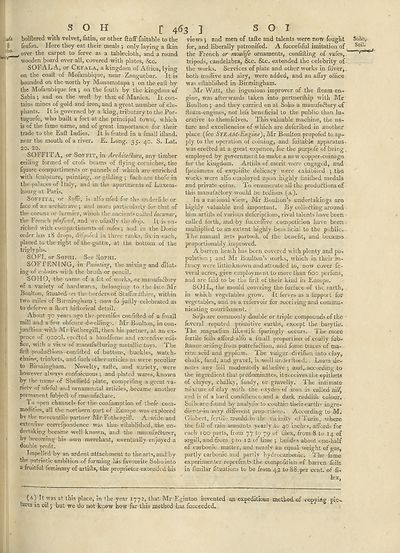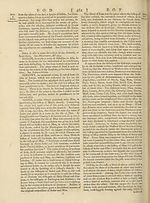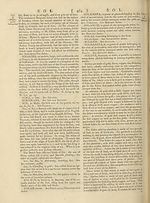Encyclopaedia Britannica, or, a Dictionary of arts, sciences, and miscellaneous literature : enlarged and improved. Illustrated with nearly six hundred engravings > Volume 19, Scripture-SUG
(509) Page 463
Download files
Complete book:
Individual page:
Thumbnail gallery: Grid view | List view

$ O H C 463 ] SOI
bolftered with velvet, fatin, or other fluff fuitable to the
feafon. Here they eat their meals ; only laying a fkin
, over the carpet to ferve as a tablecloth, and a round
wooden board over all, covered with plates, 8cc.
SOFAL A, or Cefala, a kingdom of Africa, lying
on the coaft of Mofambique, near Zanguebar. It is
bounded on the north by Monomotapa ; on the eaft by
the Mofambique fea ; on the fouth by the kingdom of
Sabia •, and on the weft by that of Manica. It con¬
tains mines of gold and iron, and a great number of ele¬
phants. It is governed by a king, tributary to the Por-
tuguefe, who built a fort at the principal town, which
is of the fame name, and of great importance for their
trade to the Eaft Indies. It is feated in a fmall ifland.
near the mouth of a river. E. Long. 35. 4c. S. Lat.
20. 20.
SOFFI 1 A, or Soffit, in Architecture, any timber
ceiling formed of crofs beams of flying corniches, the
fquare compartiments or pannels of which are enriched
with fculpture, painting, or gilding; fuch are thofe in
the palaces of Italy, and in the apartments of Luxem¬
bourg at Paris.
Soffit A, or Coffit, is alfo ufed for the underGde or
face of an architrave; and more particularly for that of
the corona or larmier, which the ancients called lacunar,
the French plafond, and we ufually the drip. It is en¬
riched with compartiments of rofes ; and in the Doric
order lias 18 drops, difpofed in three ranks, fix in each,
placed to the right of the guttoe, at the bottom of the
triglyphs.
SC)FI, or Sopiii. See Sophi.
SOFTENING, in Painting, the mixing and dilut¬
ing of colours with the bruih or pencil.
SOHO, the name of a fet of works, or manufactory
of a variety of hardwares, belonging to the late Mr
Boulton, fituated on the borders of Staffordthire, within
two miles of Birmingham ; now fo juftly celebrated as
to deferve a (hurt hiftorieal detail.
About 30 years ago the premifes confifted of a fmall
mill and a few obfcure dwellings. Mr Boulton, in con-
junftion with Mr Fothergill, then his partner, at an ex¬
pence of 900DI. eredted a handfome and extenfive edi¬
fice, with a view of manufacturing metallic toys. The
firft productions confifted of buttons, buckles, watch-
chains, trinkets, and fueh other articles as were peculiar
to Birmingham. Novelty, tafte, and variety, were
however always confpicuous ; and plated wares, known
by the name of Sheffield plate, comprifing a great va¬
riety of ufeful and ornamental articles, became another
permanent fubjedt of manufacture.
To open channels for the confumotion of thefe com¬
modities, all the northern part of Europe was explored
by the mercantile partner Mr Fothergill. A wide and
extenfive correfpondence was thus eftabliflied, The un¬
dertaking became well known, and the manufadturer,
by becoming his own merchant, eventually enjoyed a
double profit.
Impelled by an ardent attachment to the arts, and by
the patriotic ambition of forming bis favourite Soho into
a fruitful feminary of artifts, the proprietor extended his
views ; and men of tafte and talents were now fought
for, and liberally patronifed. A fuccefsful imitation of
the French or moulife ornaments, confifting of vafes,
tripods, candelabra, &c. &c. extended the celebrity of
the works. Services of plate and other works in fiiver,
both mailive and airy, were added, and an affay office
was eltablifhed in Birmingham.
Mr Watt, the ingenious improver of the fteam-en-
gine, was afterwards taken into partnerfhip with PTr
Boulton ; and they carried on at Soho a manufadtory of
fleam-engines, not lefs beneficial to the public than lu¬
crative to themfelves. This valuable machine, the na¬
ture and excellencies of which are defcribed in another
place (fee STEAM-Engine), Mr Boulton propofed to ap~
ply to the operation of coining, and fuitable apparatus-
was eredted at a great expence, for the purpof’e of being
employed by government to make a new copper-coinage
for the kingdom. Artiits of merit were engaged, and
fpecimens of exquifite delicacy were exhibited ; the
works were alfo employed upon highly finifhed medals
and private coins. To enumerate all the produdtions of
this manufadtory would be tedious (a).
In a national view, Mr Boulton’s undertakings are
highly valuable and important. By eolledting around
him artifts of various defcriptions, rival talents have been,
called forth, and by fuceeflive competition have been
multiplied to an extent highly beneficial to the public.
The manual arts partook of the benefit, and became
proportionably improved.
A barren heath has been covered with plenty and po¬
pulation ; and Air Boulton’s works, which in their in¬
fancy were little known and attended to, now cover fe-
veral acres, give employment to more than 600 perfons,
and are faid to be the firit of their kind in Europe.
SOIL, the mould covering the furface of the earth,
in which vegetables grow. It ferves as a iupport for
vegetables, and as a refervoir for receiving and commu¬
nicating nouriilrment.
So:L are commonly double or triple compounds of the
feveral reputed primitive earths, except the barytic.
The magnefian likevvjfe fparingly occurs. The more
fertile foils afford alfo a fmall proportion of coally fub-
ftance arifing from putrefaction, and fume traces of ma¬
rine acid and gypfum. The vulgar divifion into clay,
chalk, land, and gravel, is well underflood. . Loam de¬
notes any foil moderately adhetive ; and, according to
the ingredient that predominates, it receives the epithets
of clayey, chalky, fandy, or gravelly. The intimate
mixture of clay with the oxydes of iron is called ff//,
and is of a hard confiftence. and a dark reddifh colour.
Soils are found by analyfis to.contain their eartbv ingre-
diontS'in very different proportions. According to M.
Giobert, fertile mould .in the vicinitv of Turin, where
the fall of rain amounts yearly , to 40 inches, affords for
each 100 parts, from 77 to 79 of iiiex, from 8 to 14 of
argill, and from 5 to 1 2 of lime ; hendes about one-half
of carbonic matter, and nearly an equal weight of gas,
partly carbonic and partly hydrocaibonkn The fame
experimenter reprefents the compofition of barren foils
in fimilar fituations to be from 42 to 88.per cent, of fi¬
le x,
(A) It was at this place, in the year 1772, that Mr Eginton invented an expeditious method of copyiftg pic-,
tures in oil j but we do not know how far this method has fucceeded.
bolftered with velvet, fatin, or other fluff fuitable to the
feafon. Here they eat their meals ; only laying a fkin
, over the carpet to ferve as a tablecloth, and a round
wooden board over all, covered with plates, 8cc.
SOFAL A, or Cefala, a kingdom of Africa, lying
on the coaft of Mofambique, near Zanguebar. It is
bounded on the north by Monomotapa ; on the eaft by
the Mofambique fea ; on the fouth by the kingdom of
Sabia •, and on the weft by that of Manica. It con¬
tains mines of gold and iron, and a great number of ele¬
phants. It is governed by a king, tributary to the Por-
tuguefe, who built a fort at the principal town, which
is of the fame name, and of great importance for their
trade to the Eaft Indies. It is feated in a fmall ifland.
near the mouth of a river. E. Long. 35. 4c. S. Lat.
20. 20.
SOFFI 1 A, or Soffit, in Architecture, any timber
ceiling formed of crofs beams of flying corniches, the
fquare compartiments or pannels of which are enriched
with fculpture, painting, or gilding; fuch are thofe in
the palaces of Italy, and in the apartments of Luxem¬
bourg at Paris.
Soffit A, or Coffit, is alfo ufed for the underGde or
face of an architrave; and more particularly for that of
the corona or larmier, which the ancients called lacunar,
the French plafond, and we ufually the drip. It is en¬
riched with compartiments of rofes ; and in the Doric
order lias 18 drops, difpofed in three ranks, fix in each,
placed to the right of the guttoe, at the bottom of the
triglyphs.
SC)FI, or Sopiii. See Sophi.
SOFTENING, in Painting, the mixing and dilut¬
ing of colours with the bruih or pencil.
SOHO, the name of a fet of works, or manufactory
of a variety of hardwares, belonging to the late Mr
Boulton, fituated on the borders of Staffordthire, within
two miles of Birmingham ; now fo juftly celebrated as
to deferve a (hurt hiftorieal detail.
About 30 years ago the premifes confifted of a fmall
mill and a few obfcure dwellings. Mr Boulton, in con-
junftion with Mr Fothergill, then his partner, at an ex¬
pence of 900DI. eredted a handfome and extenfive edi¬
fice, with a view of manufacturing metallic toys. The
firft productions confifted of buttons, buckles, watch-
chains, trinkets, and fueh other articles as were peculiar
to Birmingham. Novelty, tafte, and variety, were
however always confpicuous ; and plated wares, known
by the name of Sheffield plate, comprifing a great va¬
riety of ufeful and ornamental articles, became another
permanent fubjedt of manufacture.
To open channels for the confumotion of thefe com¬
modities, all the northern part of Europe was explored
by the mercantile partner Mr Fothergill. A wide and
extenfive correfpondence was thus eftabliflied, The un¬
dertaking became well known, and the manufadturer,
by becoming his own merchant, eventually enjoyed a
double profit.
Impelled by an ardent attachment to the arts, and by
the patriotic ambition of forming bis favourite Soho into
a fruitful feminary of artifts, the proprietor extended his
views ; and men of tafte and talents were now fought
for, and liberally patronifed. A fuccefsful imitation of
the French or moulife ornaments, confifting of vafes,
tripods, candelabra, &c. &c. extended the celebrity of
the works. Services of plate and other works in fiiver,
both mailive and airy, were added, and an affay office
was eltablifhed in Birmingham.
Mr Watt, the ingenious improver of the fteam-en-
gine, was afterwards taken into partnerfhip with PTr
Boulton ; and they carried on at Soho a manufadtory of
fleam-engines, not lefs beneficial to the public than lu¬
crative to themfelves. This valuable machine, the na¬
ture and excellencies of which are defcribed in another
place (fee STEAM-Engine), Mr Boulton propofed to ap~
ply to the operation of coining, and fuitable apparatus-
was eredted at a great expence, for the purpof’e of being
employed by government to make a new copper-coinage
for the kingdom. Artiits of merit were engaged, and
fpecimens of exquifite delicacy were exhibited ; the
works were alfo employed upon highly finifhed medals
and private coins. To enumerate all the produdtions of
this manufadtory would be tedious (a).
In a national view, Mr Boulton’s undertakings are
highly valuable and important. By eolledting around
him artifts of various defcriptions, rival talents have been,
called forth, and by fuceeflive competition have been
multiplied to an extent highly beneficial to the public.
The manual arts partook of the benefit, and became
proportionably improved.
A barren heath has been covered with plenty and po¬
pulation ; and Air Boulton’s works, which in their in¬
fancy were little known and attended to, now cover fe-
veral acres, give employment to more than 600 perfons,
and are faid to be the firit of their kind in Europe.
SOIL, the mould covering the furface of the earth,
in which vegetables grow. It ferves as a iupport for
vegetables, and as a refervoir for receiving and commu¬
nicating nouriilrment.
So:L are commonly double or triple compounds of the
feveral reputed primitive earths, except the barytic.
The magnefian likevvjfe fparingly occurs. The more
fertile foils afford alfo a fmall proportion of coally fub-
ftance arifing from putrefaction, and fume traces of ma¬
rine acid and gypfum. The vulgar divifion into clay,
chalk, land, and gravel, is well underflood. . Loam de¬
notes any foil moderately adhetive ; and, according to
the ingredient that predominates, it receives the epithets
of clayey, chalky, fandy, or gravelly. The intimate
mixture of clay with the oxydes of iron is called ff//,
and is of a hard confiftence. and a dark reddifh colour.
Soils are found by analyfis to.contain their eartbv ingre-
diontS'in very different proportions. According to M.
Giobert, fertile mould .in the vicinitv of Turin, where
the fall of rain amounts yearly , to 40 inches, affords for
each 100 parts, from 77 to 79 of iiiex, from 8 to 14 of
argill, and from 5 to 1 2 of lime ; hendes about one-half
of carbonic matter, and nearly an equal weight of gas,
partly carbonic and partly hydrocaibonkn The fame
experimenter reprefents the compofition of barren foils
in fimilar fituations to be from 42 to 88.per cent, of fi¬
le x,
(A) It was at this place, in the year 1772, that Mr Eginton invented an expeditious method of copyiftg pic-,
tures in oil j but we do not know how far this method has fucceeded.
Set display mode to:
![]() Universal Viewer |
Universal Viewer | ![]() Mirador |
Large image | Transcription
Mirador |
Large image | Transcription
Images and transcriptions on this page, including medium image downloads, may be used under the Creative Commons Attribution 4.0 International Licence unless otherwise stated. ![]()
| Permanent URL | https://digital.nls.uk/192701899 |
|---|
| Attribution and copyright: |
|
|---|
| Description | Ten editions of 'Encyclopaedia Britannica', issued from 1768-1903, in 231 volumes. Originally issued in 100 weekly parts (3 volumes) between 1768 and 1771 by publishers: Colin Macfarquhar and Andrew Bell (Edinburgh); editor: William Smellie: engraver: Andrew Bell. Expanded editions in the 19th century featured more volumes and contributions from leading experts in their fields. Managed and published in Edinburgh up to the 9th edition (25 volumes, from 1875-1889); the 10th edition (1902-1903) re-issued the 9th edition, with 11 supplementary volumes. |
|---|---|
| Additional NLS resources: |
|

